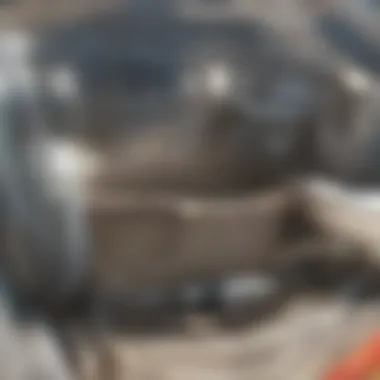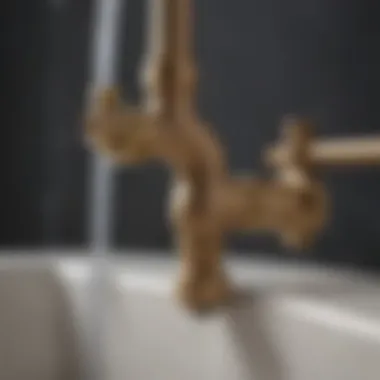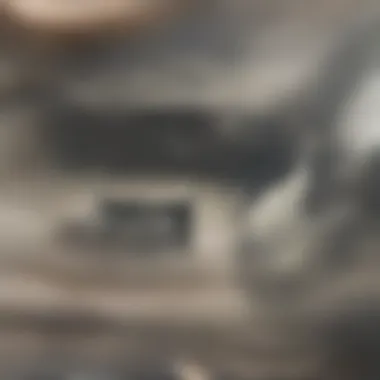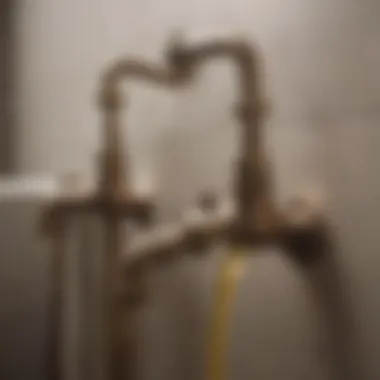Understanding Plumbing Choke Pipes: Causes and Solutions


Intro
In the world of plumbing, choke pipes present a significant challenge. Understanding these pipes, their causes, impacts, and solutions is essential for homeowners and professionals alike. A choke in plumbing refers to a restriction or blockage in the flow of water through a pipe. This condition can lead to various issues, ranging from inconvenient slow drainage to costly damage in residential and commercial properties. The underlying causes of such chokes can vary widely, including debris accumulation, improper pipe installation, or even corrosion. Each of these factors requires careful consideration and specific approaches for effective resolution.
Recognizing the potential impacts of choke pipes is critical for maintaining the integrity of plumbing systems. The issues may not just be confined to reduced water flow; they can escalate into serious structural problems if left unaddressed. Ultimately, this article aims to provide a detailed examination of choke pipes. It will outline their complexities and emphasize effective strategies for prevention and maintenance.
By gaining insights into choke pipes, readers can be better equipped to ensure optimal plumbing conditions in their properties.
Intro to Plumbing Choke Pipes
Plumbing choke pipes are a critical concern in both residential and commercial structures. Understanding them is essential to ensure effective maintenance and prevention strategies. When choke pipes occur, they can lead to significant disruptions in water flow, which ultimately affects daily operations and comfort. Proactively learning about choke pipes can lead to long-term benefits, sparing individuals and businesses from costly repairs and emergencies.
Definition of Plumbing Choke Pipe
A plumbing choke pipe refers to a section of the plumbing system that is blocked or partially obstructed. This blockage can hinder the flow of water, leading to reduced pressure and slow drainage. Common signs of a choke pipe include gurgling sounds from drains, slow draining sinks, and often unpleasant smells emanating from the plumbing fixtures. The definition encapsulates a variety of obstructions, from debris and grease to tree roots that infiltrate the pipes and disrupt the intended function.
Importance of Understanding Choke Pipes
Comprehending the phenomenon of choke pipes holds great significance. Firstly, awareness leads to better maintenance practices. Property owners who understand the causes and signs of choke pipes are more likely to engage in regular inspections. This preventative measure can save time and money in the long run.
Additionally, recognizing the implications of choke pipes is crucial. The effects are not always obvious at first. Slow drains might seem minor, but they can escalate to severe issues, such as pipe bursts or extensive water damage. A thorough understanding enables proactive measures, thus ensuring plumbing systems function efficiently.
Furthermore, information regarding choke pipes can guide homeowners and businesses in selecting the right plumbing services when issues arise. Knowing the right questions to ask and evaluating different services hinges on overall understanding. As a result, the journey through plumbing challenges becomes more manageable.
How Plumbing Choke Pipes Form
Understanding how plumbing choke pipes form is crucial to prevent and manage plumbing issues effectively. This section delves into the primary factors that lead to choking in pipes. Gaining insight into these causes can enable home and property owners to implement preventative measures, thereby prolonging the life of their plumbing systems and avoiding costly repairs.
Common Causes of Choking in Pipes
Debris accumulation
Debris accumulation occurs when foreign materials such as hair, soap residue, and small objects gather within the plumbing pipes. This buildup gradually restricts the flow of water and can lead to choking. The key characteristic of this type of blockage is its gradual nature, often going unnoticed until it causes significant drainage issues.
It is a popular choice for this article because it illustrates how everyday activities contribute to plumbing problems. The unique feature of debris accumulation is that it can often be managed through simple maintenance practices, like regular cleaning of drains and traps. However, negligence can lead to more severe issues down the line.
Grease buildup
Grease buildup is a common issue in kitchen plumbing systems, especially in areas where fats and oils are frequently disposed of down the sink. The main aspect of this clogging is its sticky nature, which allows it to attract other debris, worsening the blockage. This information is beneficial for our audience as it highlights the critical relationship between kitchen practices and plumbing health.
A unique feature of grease buildup is that it solidifies as it cools, significantly narrowing pipe diameter over time. Its advantage lies in the fact that prevention is straightforward; by avoiding dumping grease down the drain, one can mitigate the problem effectively.
Tree root intrusion
Tree root intrusion is a less recognized cause of choking in pipes but can lead to extensive damage. This occurs when roots from nearby trees grow into the plumbing system, seeking moisture.
The key characteristic of tree root intrusion is that it often goes undetected until considerable problems arise. The choice to include this topic here underscores the importance of landscaping considerations in plumbing health.
A unique feature of this type of blockage is its potential for causing structural issues in the plumbing system. Its downside is that it often requires professional intervention to remove roots and repair any damage caused.
Chemical Reactions and Their Role
In addition to physical blockages, chemical reactions inside pipes can exacerbate choking. These reactions often occur due to the interaction of common household chemicals with substances already present in the plumbing system. Understanding how chemical reactions can impact your plumbing is pertinent for maintaining a functional infrastructure. Chemical reactions can lead to corrosion or other forms of deterioration, worsening plumbing conditions in the long term. Identifying the right materials in plumbing systems can prevent adverse reactions, ensuring a longer lifespan for the pipes.


"Preventing choking in plumbing systems is not only about understanding physical blockages but also about recognizing the impact of chemical reactions."
Overall, understanding how plumbing choke pipes form allows homeowners and commercial property owners to take a proactive approach to plumbing maintenance. By being aware of causes such as debris accumulation, grease buildup, tree root intrusion, and chemical reactions, one can take steps toward maintaining optimal plumbing conditions.
Impact of Choke Pipes on Plumbing Systems
Understanding the impact of choke pipes on plumbing systems is crucial for homeowners and commercial property managers alike. The existence of choke pipes can severely disrupt water flow, compromise the integrity of plumbing fixtures, and ultimately lead to significant financial consequences. It is essential to recognize these impacts to implement effective prevention and repair strategies.
Residential Implications
Water flow reduction
Water flow reduction is a major concern when dealing with choke pipes. It indicates decreased efficiency in residential plumbing systems. When water flow is impaired, it creates inconvenience in daily activities like bathing, cleaning, and cooking. The reduction in water flow arises when debris or grease accumulates within pipes, leading to partial blockages. If this issue is not addressed quickly, it can escalate into complete shut-off or severe pressure fluctuations.
Key characteristic of this reduction is its gradual nature. Homeowners might not notice the changes immediately, making it seem less urgent. However, it's a significant issue that can affect daily comfort and functionality.
This situation highlights the need for regular inspection and timely maintenance. Ignoring early signs can have severe consequences. Thus, understanding the reduction of water flow is a beneficial aspect of addressing choke pipes.
Damage to fixtures
Damage to fixtures is another critical impact of choke pipes. As water pressure fluctuates, plumbing fixtures can become strained, leading to leaks or even burst pipes. This situation may cause additional unexpected costs for repairs or replacements. The relationship between choke pipes and damage to fixtures is direct; when pipes choke, it often puts excess strain on fixtures.
This aspect is often overlooked because fixtures are usually not considered until there's a visible problem. However, ignoring these signs can lead to more severe plumbing issues down the line. It emphasizes the importance of proactive measures to prevent choking, ultimately safeguarding one's investment in plumbing fixtures.
Commercial Consequences
Operational disruptions
Operational disruptions in commercial settings can be severe. Choke pipes can halt water flow entirely, leading to disruptions in daily operations. Whether it’s a restaurant, an office, or a factory, consistent water supply is fundamental for productivity. If employees or customers face interrupted services due to choke pipes, this can result in significant downtime.
Companies rely heavily on smooth water flow to function effectively. Thus, understanding the operational impacts of choke pipes is paramount for protecting productivity. The unique feature of these disruptions is they often are not isolated incidents. A single choking event can lead to cascading effects throughout the organization.
Financial impacts
The financial impacts of choke pipes are equally significant. Lost productivity translates to lost revenue, directly affecting a company's bottom line. Repairs to plumbing systems can also incur high costs, especially if they require urgent intervention.
Investing in preventative measures may seem like an additional expense, but the avoidance of financial fallout from choking incidents makes it a wise choice. This reflects the broader idea that a small investment in prevention can lead to major savings in the long run. Understanding financial implications qualifies it as a crucial element in the discussion of choke pipes.
In summary, both residential and commercial sectors face serious challenges from choke pipes. Addressing these issues requires an informed approach, emphasizing proactive measures and early detection to minimize negative impacts.
Preventative Measures Against Choke Pipes
Preventative measures against choke pipes are essential for maintaining optimal plumbing conditions. Understanding these strategies is crucial, as they can save homeowners and commercial property managers from significant future expenses related to repairs and flooding. By implementing effective preventative actions, individuals can ensure a more reliable plumbing system, ultimately enhancing the longevity of pipes and fixtures. This section discusses various approaches that can significantly reduce the likelihood of choke pipes.
Regular Maintenance Practices
Regular maintenance is foundational in preventing choke pipes. This aspect includes both inspection routines and cleaning protocols, which together contribute to a proactive plumbing management strategy.


Inspection routines
Regular inspection routines allow early detection of potential issues before they escalate. These inspections should be systematic, occurring at least once a year. A key characteristic of inspection routines is their focus on assessing the state of pipes, both above and below ground. This method is beneficial because it identifies small blockages and weaknesses in the plumbing system early on, before they cause significant problems.
The unique feature of inspection routines lies in their comprehensive nature. A plumbing professional usually evaluates physical conditions, checks for leaks, and uses cameras to observe the internal structures of pipes. The primary advantage of this approach is that it can prevent costly repairs later, with minimal investment in time and resources.
Cleaning protocols
Cleaning protocols are another essential element in maintaining clear pipes. They involve regular and thorough cleaning of drains and pipes to remove buildup. A major characteristic of cleaning protocols is their routine application, typically conducted every few months. This is a beneficial choice since it directly addresses the common causes of choking, such as grease and debris accumulation.
The unique aspect of cleaning protocols is the variety of methods available. From basic methods like plunging to more advanced techniques such as hydro jetting, the options can suit various needs and budgets. The advantage of these protocols is clear: they not only keep pipes flowing but also prolong their lifespan.
Effective Use of Drainage Systems
Using drainage systems effectively is a vital preventative measure. Employing the right drainage design helps in managing water flow and preventing backlogs that can lead to choke pipes. This aspect also includes proper installation and maintenance of drainage systems to avoid future complications.
An efficient drainage system should include adequate grading and the right size of pipes to handle expected water flow. Regular monitoring for blockages is equally critical. Importantly, individuals should avoid throwing inappropriate items down drains to prevent unnecessary clogs.
Taking these steps seriously can lead to fewer plumbing issues down the line.
"Regular maintenance and effective drainage are the cornerstones of preventing plumbing choke pipes. Ignoring these practices often leads to larger, more expensive problems.”
Mitigating Choke Pipe Issues
The need for mitigating choke pipe issues is crucial for maintaining the efficiency and longevity of plumbing systems. Understanding the symptoms and repair techniques can prevent more significant problems in the future. Proper identification and resolution of these issues can result in not just improved water flow but also savings on costly repairs.
Identifying Symptoms of Choked Pipes
Slow drainage
Slow drainage is often the first noticeable symptom of a choke pipe. This condition is caused by blockages forming in the plumbing lines that hinder water flow. When drains do not empty as expected, many homeowners may ignore the problem at first, thinking it is a minor inconvenience. However, consistent slow drainage can escalate into more serious plumbing issues if not addressed.
Some key characteristics of slow drainage include water pooling in sinks or bathtubs. This symptom is a beneficial indicator for this article because it highlights the necessity for vigilance in plumbing maintenance. Identifying slow drainage early can prevent damage to pipes or fixtures that result from excessive pressure due to clogs.
Advantages of addressing slow drainage promptly include improved hygiene and reduction of unpleasant odors that often accompany standing water. Conversely, if ignored, this minor symptom can develop into significant plumbing crises, requiring extensive repairs.
Unpleasant odors
Unpleasant odors emanating from drains can signal underlying plumbing problems often associated with choke pipes. These odors may arise from decomposing organic material trapped in the pipes or stagnation of dirty water. This symptom is crucial in understanding plumbing choke issues because it serves as an alert that intervention is needed.
The key characteristic of unpleasant odors is their ability to indicate not just blockages but potential health risks as well. The presence of such smells turns attention to maintenance needs that, when addressed swiftly, can enhance overall home environment.
In this article, paying attention to unpleasant odors can empower homeowners to take action before a simple blockage turns into a costly plumbing emergency. The unique feature of this symptom is how easily it can be recognized often without any specialized knowledge. Addressing it early can save substantial time and money, while also improving living conditions.
Repair Techniques
Snaking methods
Snaking methods are a commonly employed technique for clearing clogged pipes. This method involves using a long, flexible tool called a plumber's snake that is inserted into the drain. The primary aspect of this technique is its effectiveness in reaching and breaking apart blockages deep within the plumbing. Snaking is a popular choice for this article because it can resolve many clogging situations without requiring extensive disassembly.
The unique feature of snaking methods is their ability to deal with a range of issues, from hair clogs in household sinks to tree root intrusions in outdoor lines. While effective, there can be some disadvantages, such as the potential for damaging older pipes if excessive force is used. Homeowners should weigh their options carefully.


Hydro jetting
Hydro jetting represents a more advanced technique that uses high-pressure water to clear blockages. This method is effective for significant build-up or extensive debris as well as grease clogs. Hydro jetting's key characteristic is its power; it can remove tough blockages that other methods often leave behind, making it a beneficial solution highlighted in this article.
One unique aspect of hydro jetting is its environmental consideration. Using only water means there are no harsh chemicals introduced into plumbing systems, which is a significant advantage. However, it's essential to note that this method may not be suitable for all pipe types, especially older or fragile systems. It can also require professional handling to ensure effectiveness and avoid damage.
The Role of Professional Plumbers
The domain of plumbing is intricate and multifaceted, especially when it comes to managing choke pipes. Professional plumbers serve as pivotal figures in this scenario. Their expertise ensures that choke pipes are not only addressed effectively but also that the underlying causes are understood and mitigated. This role is critical for both residential and commercial properties, where the ramifications of neglect can lead to compounded issues such as extensive water damage or costly repairs.
When to Call a Professional
Recognizing the signs of a choke pipe is essential, yet knowing when to solicit professional help can be challenging. Homeowners might initially attempt small repairs; however, there are cases when these attempts do not suffice, and further intervention is needed. If you notice persistent slow drainage, recurring clogs, or foul odors that seem to stem from the plumbing system, it is prudent to call a licensed plumber. Ignoring these symptoms can lead to more severe consequences, such as complete blockage or even pipe failure.
Choosing the Right Plumbing Service
Selecting a competent plumbing service is crucial for effective management of choke pipes. Not all services provide the same level of quality or expertise. Here are some key factors to consider:
Qualifications and expertise
The qualifications of a plumber directly impact the level of service they can provide. Professional plumbers should possess relevant licenses and certifications. These indicatives affirm their training and commitment to industry standards. A well-qualified plumber not only understands the technical aspects of plumbing but also possesses problem-solving abilities essential for troubleshooting choke pipe issues. Their familiarity with modern techniques, such as hydro jetting or camera inspections, is a considerable advantage in effective diagnosis and resolution.
Customer reviews and feedback
Customer reviews are invaluable when assessing a plumbing service. They offer insights into past client experiences, highlighting strengths and weaknesses. A reputable plumbing company often boasts positive feedback, indicating reliability and professionalism. Look for reviews that emphasize punctuality, efficiency, and quality workmanship. While some negative reviews are common across all industries, it is the general trend that matters. Persistent issues pointed out by customers may signify service flaws.
Considering customer feedback and the qualifications of a plumber, ensures informed decisions that benefit plumbing conditions in the long run.
Innovative Technologies in Plumbing
Innovative technologies in plumbing are transforming the way we address plumbing issues, especially choke pipes. These advancements serve multiple purposes, enhancing the efficiency of plumbing systems, facilitating better maintenance, and minimizing the impacts of choke pipes on residential and commercial infrastructures. Understanding these technologies helps homeowners and property managers make informed decisions about their plumbing strategies.
Smart Plumbing Systems
Smart plumbing systems encompass a range of technologies that integrate sensors, automation, and advanced monitoring tools to improve plumbing management. These systems can detect leaks, monitor water usage, and assess pressure levels in real-time. By employing a smart plumbing system, one can gain immediate insights into the condition of plumbing pipes, identifying potential choke scenarios before they escalate into significant issues.
The benefits of smart plumbing systems include:
- Real-time monitoring: Immediate alerts about leaks or blockages can prevent severe damage and costly repairs.
- Data analytics: This allows homeowners to analyze their water usage patterns, leading to more efficient water conservation.
- Remote access: Many smart systems offer mobile app integration, providing easy control over plumbing features.
These technologies often reduce stress levels associated with traditional plumbing maintenance. They empower users by providing visibility and understanding of plumbing systems.
Emerging Solutions for Choked Pipes
Emerging solutions for choked pipes include a variety of advanced techniques and products designed to combat choke issues effectively. Some of these solutions prioritize sustainability, while others focus on efficacy, ensuring that plumbing systems remain unobstructed.
A few noteworthy emerging solutions are:
- Enzyme-based cleaners: These biological agents break down organic matter in pipes gently and effectively, offering a safer alternative to harsh chemicals.
- Advanced pipe inspection tools: Tools like high-resolution cameras can identify choke points within plumbing systems, allowing for precise targeting of the problem areas.
- Robotics and machinery: Technologies such as robotic pipe inspection and cleaning offer innovative capabilities. They can navigate complex pipe systems to clean and repair without invasive methods.
Incorporating these emerging solutions not only enhances the maintenance of plumbing systems but also encourages a proactive approach to prevent future choke issues.
Investing in innovative plumbing technologies is not merely a trend but a strategic movement towards sustainability and efficiency in plumbing management.







